| Article ID | Journal | Published Year | Pages | File Type |
|---|---|---|---|---|
| 6378807 | Postharvest Biology and Technology | 2013 | 6 Pages |
â¢Peach tissues were acidified by Monilinia fructicola.â¢Gluconic acid was the main organic acid accumulated at the infection site.â¢Gluconic acid was the main organic acid produced by M. fructicola under liquid-culture conditions.â¢Acidification increased the relative induction of transcripts of mfpg 2 and mfpg3, encoding for two polygalacturonase genes of M. fructicola.
Colonization of nectarines and peaches fruit by Monilinia fructicola was accompanied by local acidification of the host tissue. The fungus acidified the host tissue in peaches and nectarines from pH 4.5 and 4.45, to pH 3.75 and 3.9, respectively. Analysis of the acidification process in colonized fruit and secondary inducing media showed that gluconic acid was the main organic acid accumulated at the infection site and under liquid-culture conditions. When comparing a nectarine cv. Big Top and peach cv. Plácido with differing sensitivities to M. fruticola, a 250% higher accumulation of gluconic acid was observed in the susceptible peach cultivar than in the less susceptible nectarine cultivar. Under liquid conditions, at pH 3.6-3.7, the relative expression of transcripts of mfpg 2 and mfpg3, encoding for two polygalacturonase genes of M. fructicola, increased 12-fold and 6-fold, respectively, suggesting the importance of acidification for the secretion of pathogenicity factors by M. fructicola. Our results indicate that ambient pH is a regulatory cue for processes linked to pathogenicity of postharvest pathogens, and that specific genes contributing to pathogenicity are expressed as a result of the environmental pH created by the pathogen.
